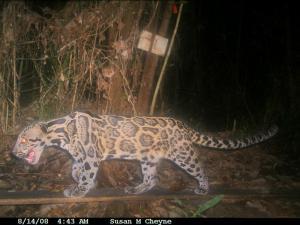Another post (see previous here, here and here) by my aspiring science-communicator PhD student, Salvador Herrando-Pérez.
–

In secondary school, most of my classmates associated the subject ‘Biology’ with unpronounceable Latin taxonomic names, with which all known living beings are branded — ‘Canis lupus’ reads the identity card of humanity’s best friend. When the Swedish monk Carl Linnaeus proposed such binomial nomenclature, he could hardly imagine that, two hundred years later, his terminology would underpin national and transnational budgets for species conservation. Taxonomic nomenclature allows the classification of species into clusters of the same kind (e.g., diatoms, amanitas, polychaetes, skinks), and the calculation of an indispensable figure for conservation purposes: how many species are there at a given location, range, country, continent, or the entire planet?
Traditionally, taxonomists described species by examining their (external and internal) morphological features, the widest consensus being that two individuals of different species could not hybridise. However, a practical objection to that thinking was that if, for instance, an ocean separated two leopard populations, ethics should prevent us from bringing them in contact only to check if they produce fertile offspring, hence justifying a common-species status. Genetics currently provides a sort of ‘remote check’.
New species, new names
Over the last three decades, the boom of genetics and the global modernisation of environmental policies have fostered alternative criteria to differentiate species, populations, and even individuals. As a result, experts have created a colourful lexicon to label management or conservation units or new taxonomical categories such as that of a subspecies1, e.g., Canis lupus dingo for the wild Australian dog (dingo). These changes have shaken the foundations of taxonomy because several definitions of species (biological, phylogenetic, evolutionary) are forced to live under the umbrella of a common nomenclature.
A striking consequence is that many subspecies are being re-classified nominally as new species — the so-called ‘taxonomic inflation’2. Taxonomic inflation does not question the authenticity of new taxa; rather, it qualifies the pattern of increasing numbers of species resulting, not from discovery of unknown forms of life, but from the taxonomic re-examination of already known ones. ‘Inflation’ is certainly a pejorative word (negatively loaded from the field of economics), and some researchers instead prefer ‘taxonomic progress’ which emphasizes the expanding availability of new data to revise species’ classifications3.

Sunda clouded leopard (Neofelis diardi) in Sabangau Forest, Borneo, Indonesia (© S. Cheyne)
Whatever we call it, and even though its causes are arguable4-6, taxonomic inflation is a reality. Meiri & Mace7 have recently illustrated the caveats of taxonomic inflation through the case of the clouded leopard (Neofelis nebulosa), a semi-arboreal feline endemic to southern Asia. The species is listed in the IUCN Red List [Status = Vulnerable C1+2a(i)] and up to recently, consisted of four subspecies. But in 2006, the subspecies living in Borneo and Sumatra (the Sunda clouded leopard: Neofelis nebulosa diardi) was lifted to species status (Neofelis diardi) following a study of pelage colour and distribution of spots (or ‘clouds’)8. In March 2007, the discovery hit the front page of the Times. And in 2008 the IUCN allocated Neofelis diardi to the category Vulnerable C1, and recognised as subspecies the populations in Borneo (Neofelis diardi borneensis) and Sumatra (Neofelis diardi diardi). From Imperial College London, Meiri & Mace7 point out that the remaining 144 known mammal species of Borneo and Sumatra, sharing an evolutionary past similar to that of the clouded leopards, would deserve identical treatment. And why not the thousands of vertebrates, invertebrates and plants living on these two megadiverse Indonesian islands?

Temporal trend of annual % of newly described over total known species of 4 mammal orders (artiodactyls, carnivores, marsupials, primates) in taxonomic studies published 1980-2004 (ref 2). The expected slope for each order is negative, i.e., the proportion of new species should decrease as the cumulative number of known species increases over time. Primates are the only order showing a positive slope, and have become the third-most speciose vertebrate order, only topped by rodents and bats. Those values do not indicate real diversity in nature, but biased research effort.
Names that taste of money
Taxonomic inflation occurs mostly among charismatic species, some of which are endangered (e.g., lemurs9), others geopolitically circumscribed — e.g., the exoticism Europeans attribute to some orchids might explain why botanists have described three times more species in some genera than are accepted10. Nonetheless large-bodied and/or human-like vertebrates monopolise the rates of taxonomic inflation (Figure 1), in particular because spectacular animals such as gorillas draw public attention, and the interest of the media and potential sponsors.
To some extent, this is good news for conservation, because many species of local plants and animals can (indirectly) benefit from measures taken to protect the habitat of those celebrity species. However, Meiri & Mace7 argue judiciously that the decision of splitting one into several species must be made on the bases of a sum of biological, ecological, genetic and morphological data, and that these criteria must be common across taxa. These authors juggle with the description of Neofelis diardi before robust genetic analyses only subsequently substantiated the species’ status11 — the isolation of insular and continental populations was dated at > 1 million years, akin to Panthera species.
The reverse situation surrounded the black turtle C. agassizii (an eastern Pacific, melanic and smaller body-sized form of green turtle Chelonia midas), for which genetic evidence in the 1990s failed to support even a subspecies status12. The false species was then downgraded in C. midas (IUCN status = Endangered A2bd), and its re-evaluation recommended the designation of ‘geopolitical management units’ for species identities preserved only on geographical, political, or cultural grounds12.
Taxonomic inflation indicates that taxonomy is an evolving research discipline and that any list of species reported to live in a region is bound to change as further discoveries are made through taxonomic refinement and surveying13,14. However, this phenomenon has at least three important implications for conservation:
- charismatic species can end up monopolizing resources that could be invested otherwise in conservation15
- regional diversity estimates will be inflated if taxonomic inflation is flawed, so ‘Hotspots‘ might look even hotter16
- extinction rates will be over- or under-estimated depending on the species concepts experts use across taxa17.
Thus, the populations of Neofelis diardi are more likely to go extinct as a species now than when Neofelis nebulosa comprised the four subspecies. Whether taxonomic inflation is a good or a bad thing should not deflect our concerns about currently accelerating rates of extinction threatening ecosystem functions and services worldwide.
Acknowledgment: I am grateful to Stephen Gregory for comments that improved an earlier version of this article.
Salvador Herrando-Pérez
Literature cited
- Cronin, M. A. A proposal to eliminate redundant terminology for intra-species groups. Wildl. Soc. Bull. 34, 237-241, doi:10.2193%2F0091-7648%282006%2934%5B237%3AAPTERT%5D2.0.CO%3B2 (2006).
- Isaac, N. J. B., Mallet, J. & Mace, G. M. Taxonomic inflation: its influence on macroecology and conservation. Trends Ecol. Evol. 19, 464-469, doi:10.1016/j.tree.2004.06.004 (2004).
- Sangster, G. Increasing numbers of bird species result from taxonomic progress, not taxonomic inflation. Proc. R. Soc. B-Biol. Sci. 276, 3185-3191, doi:10.1098/rspb.2009.0582 (2009).
- Harris, D. J. & Froufe, E. Taxonomic inflation: species concept or historical geopolitical bias? Trends Ecol. Evol. 20, 6-7, doi:10.1016/j.tree.2004.11.004 (2005).
- Knapp, S., Lughadha, E. N. & Paton, A. Taxonomic inflation, species concepts and global species lists. Trends Ecol. Evol. 20, 7-8, doi:10.1016/j.tree.2004.11.001 (2005).
- Mallet, J., Isaac, N. J. B. & Mace, G. M. Response to Harris and Froufe, and Knapp et al: Taxonomic inflation. Trends Ecol. Evol. 20, 8-9, doi:10.1016/j.tree.2004.11.002 (2005).
- Meiri, S. & Mace, G. M. New taxonomy and the origin of species. PLoS Biol. 5, e194, doi:10.1371%2Fjournal.pbio.0050194 (2007).
- Kitchener, A. C., Beaumont, M. A. & Richardson, D. Geographical variation in the clouded leopard, Neofelis nebulosa, reveals two species. Curr. Biol. 16, 2377-2383, doi:10.1016/j.cub.2006.10.066 (2006).
- Tattersall, I. Madagascar’s lemurs: Cryptic diversity or taxonomic inflation? Evol. Anthropol. 16, 12-23, doi:10.1002/evan.20126 (2007).
- Pillon, Y. & Chase, M. W. Taxonomic exaggeration and its effects on orchid conservation. Conserv. Biol. 21, 263-265, doi:10.1111/j.1523-1739.2006.00573.x (2007).
- Wilting, A. et al. Clouded leopard phylogeny revisited: support for species recognition and population division between Borneo and Sumatra. Front. Zool. 4, 15, doi:10.1186/1742-9994-4-15 (2007).
- Karl, S. A. & Bowen, B. W. Evolutionary significant units versus geopolitical taxonomy: molecular systematics of an endangered sea turtle (Genus Chelonia). Conserv. Biol. 13, 990-999, doi:10.1046%2Fj.1523-1739.1999.97352.x (1999).
- Padial, J. M. & De la Riva, I. Taxonomic inflation and the stability of species lists: The perils of ostrich’s behavior. Syst. Biol. 55, 859-867, doi:10.1080/1063515060081588 (2006).
- Thompson, K. Do We Need Pandas? The Uncomfortable Truth about Biodiversity (Green Books, 2010).
- Moses, K. Species vs ecosystems: save the tiger or focus on the bigger issues? The Ecologist (2 January 2011).
- Chaitra, M. S., Vasudevan, K. & Shanker, K. The biodiversity bandwagon: the splitters have it. Curr. Sci. 86, 897-899 (2004).
- Agapow, P.-M. et al. The impact of species concept on biodiversity studies. Quart. Rev. Biol. 79, 161-179, doi:10.1086/383542 (2004).

